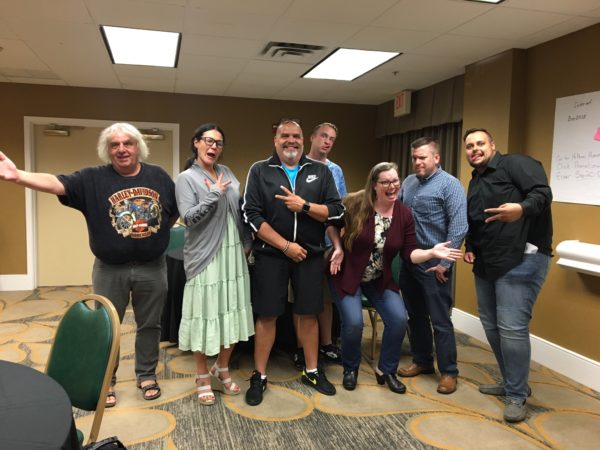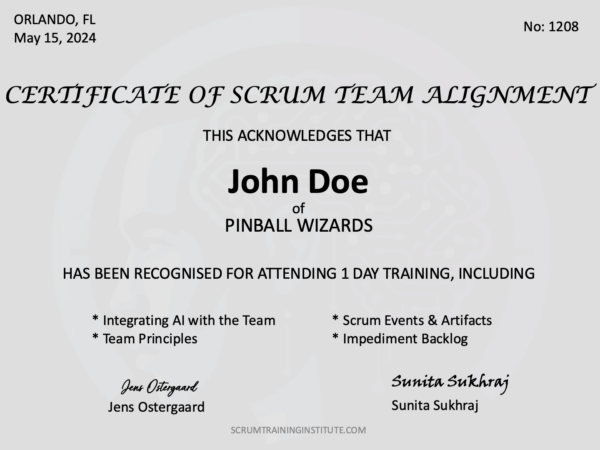Scrum Team Alignment

Introduction
In today’s Agile world, the spotlight has shifted from just focusing on Scrum at the team level to pushing for overall organizational agility. For a successful Agile transformation, it’s key for every Scrum Team to be on the same page about what Scrum is all about. This means understanding the core of Scrum, the power of being a self-managing team, and other important basics.
We know your Agile journey is moving forward, and things are getting better. Sometimes, everything runs smoothly and your team adapts quickly; other times, progress can be slow. There are many reasons for this, like resistance within the organization, not enough team empowerment, or not fully understanding Scrum. This is often summed up as “We do Scrum but…”. For example, “We do Scrum, but our Product Owner doesn’t have the final say on prioritizing the Product Backlog.”
Another big factor in the world of Scrum teams is Artificial Intelligence (AI). In this class, we’ll talk about practical ways AI can be used within Scrum Teams, even though AI is still in its early days.
As we move towards true agility, make sure your Scrum Team is on track and understands the core of Scrum. Join our one-day Scrum Team Alignment class for a deep dive into the core of Scrum. As Ken Schwaber once told Jens, “The Devil is in the Details.”
Scrum Guides Generative AI Contact Us
Agenda
Introduction
- Welcome and Introduction
- Trainers:
- Overview of Exercises and Videos
- The Heart of Scrum
- You Don’t Have to Do Scrum
- Scrum & AI
Main Topics
- Integrating AI with a Scrum Team
- Video: Generative AI
- Practical Applications of AI in Scrum Teams
- Team Principles
- 12 characteristics of a great team
- Autonomous Teams
- Working Agreements
- Keep it concise; focus on what’s most important
- Accountability Over Roles
- Team Members (ScrumMaster, Product Owner, Developer)
- Scrum Events
- Sprint Planning
- Daily Scrum
- Sprint Review
- Retrospective
- Product Backlog Refinement
- Scrum Artifacts
- Product Backlog Management
- Sprint Backlog Management
- Product Increment
- Build-ability, Clean Code, User Outcome/Benefit
- Additional Key Topics
- Dependencies
- Minimize Dependencies (feature teams)
- Guest Team member (internally or externally)
- Continues improvement
- Technical Skills
- Swarming
- Collective code ownership
- Mob
- TDD
- Refactoring
- Testing
- Automated Acceptance
- User Accepted
- Exploratory
- Value Stream Mapping
- Impediment Backlog
- Examples: Delays, PO Availability, Delivery of User Value
- What can we change, influence, not do anything about
- Integration into Retrospectives
- Dependencies
Closing Event
- Team Photo
- Certificate of Completion
- Team Name
- Picture
- Individual Names
Details
Our Accountabilities Includes:
- One day “Scrum Team Alignment” class
- Bounded Course Material
- Certificate of Completion
- Travel, lodging, etc.
Your accountabilities include: (We can be helpful with arrangements)
- Venue
- Lunch
- Projector/TV
- Flip Chart
- Post-it Notes
- Any other necessary materials
Pre-requirements:
- Read the Scrum Guide: Ensure all participants have read the Scrum Guide beforehand.
- Full Team Attendance: The Scrum Team should attend (maximum of 10 participants).
Take this opportunity to refine your Scrum skills with expert guidance. Align your practices for success, together. As a Scrum Team, we are all in this together with no hierarchy.
Cheers to continued growth!

